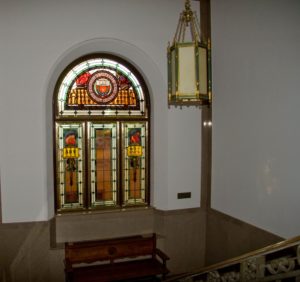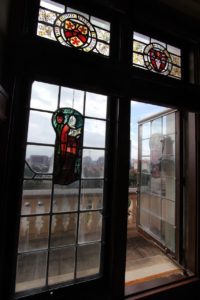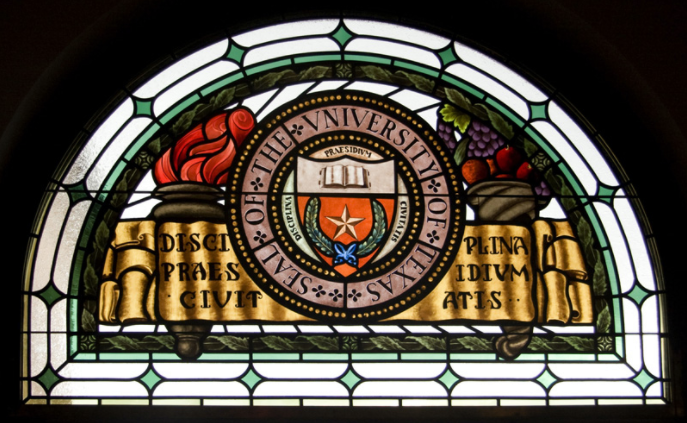Historical stained glass window restoration is one of Stanton Studios’ specialties. Our studio has received windows from all over the United States to restore to their original condition. We have restored windows from very famous stained glass artists, such as L.C Tiffany, the J&R Lamb brothers, F.X. Zettler, Franz Mayer, and Charles J. Connick. We believe stained glass restoration is an opportunity to go back in time and better understand the form and expression in the artist’s works.
One of our favorite restoration projects we’ve worked on in the past was for the Presidential Suite of The Main Building at the University of Texas in Austin in 2015. The stained glass windows we acquired from the Presidential Suite were dated circa the 1920s. Upon further inspection, Stanton Studios found evidence of an obscure, hand-scribed signature of Charles J. Connick in one of the office windows.
Charles J. Connick had a well-known and established stained glass business in Boston, Massachusetts, during the same time that Louis Comfort Tiffany operated his studio in New York City. Each artist had a different taste and style, and their windows can be a testament to their artistic flare. Connick’s glass resembled the High Gothic era of stained glass from medieval times. This involved cutting the window into small, colorful pieces and painting with dark, thick lines without a lot of shading.
 We have been working with UT Austin since 2007, and our first project entailed replicating a missing arched stained glass window and restoring several other windows that had been severely damaged in a hailstorm. Using a copy of an old black-and-white newspaper photo taken in the 1940s to recreate the look of the original hand-painted leaded glass window, we took down the plywood that had for years filled in for the missing window and reinstalled the newly replicated window.
We have been working with UT Austin since 2007, and our first project entailed replicating a missing arched stained glass window and restoring several other windows that had been severely damaged in a hailstorm. Using a copy of an old black-and-white newspaper photo taken in the 1940s to recreate the look of the original hand-painted leaded glass window, we took down the plywood that had for years filled in for the missing window and reinstalled the newly replicated window.
In 2015, Stanton Studios worked on restoring and repairing twenty-one 90-year-old windows for UT Austin by using our accredited restoration techniques for historical preservation and conservation.
When beginning a new restoration job, we carefully document and photograph each window to start. Then, our craftsmen remove the rebar from the window and soak the entire piece in water to loosen the grout and lead, preventing the toxic lead and grout particles from becoming airborne. After this, they take the window and make three “gravestone” rubbings for rebuilding purposes. After the rubbings are complete, we remove the old, fatigued lead from the window and clean the glass in a mild cleaning solution.
Taking care, our workers then remove any excess grout from the glass and place the pieces on the gravestone rubbing to rebuild it. We note any breaks or cracked glass and match and replace any glass pieces that cannot be salvaged. The building of the window follows while the workers use restoration-quality lead. Finally, the craftsmen will “mud” or “grout” the window and reinstall it into the original window location.
For UT Austin project in 2015, we reinstalled all the windows using an isothermal glazing system that Stanton Studios has employed successfully in the past. This system is designed to vent for the stained glass and protect the delicate artworks from weather and potential damage. We use protective glass on the windows exterior, and relocate the windows in front of the protective glass using bronze frames. This provides air circulation to flow in between the two windows, and keeps the stained glass from being a barrier to the outside. Using a system like this will prolong the window’s life and protect the painted surfaces.
 The windows from UT Austin also have an exciting story behind the hand-painted glass. Connick designed eight large window panels that depict the eight genres of literature using feminine figurines. The windows are a representation of comedy, fiction, lyrical poetry, epic poetry, fables, debate, and history. The Latin translations are not completely clear on all the windows, nor is it apparent why Connick chose to depict these ideas in this interesting way.
The windows from UT Austin also have an exciting story behind the hand-painted glass. Connick designed eight large window panels that depict the eight genres of literature using feminine figurines. The windows are a representation of comedy, fiction, lyrical poetry, epic poetry, fables, debate, and history. The Latin translations are not completely clear on all the windows, nor is it apparent why Connick chose to depict these ideas in this interesting way.
In addition to the muses, Connick also included various crests from colleges like Oxford and Cambridge. It remains a mystery why he carefully selected the particular crests that he did, and what his Latin inscriptions mean.
Every project that comes through our doors is a story, and some even become mysteries that we have the challenge to try and solve. We love working in our line of business because every project has a tale of its own. Besides creating custom pieces for clients, we thrive on restoration projects like the one at UT Austin, where we get to bring historical pieces back to life.



